tubing (B) Swimming is an important occupation for health and wellness, and is placed within the societal norms of families and children. There are five contextual layers to the bioecological model. Through this view, occupations are considered as “extending beyond a single person’s experience to encompass others and the social, physical[,] and cultural world (Dickie, Cutchin, Humphry, 2006, p. 85). Layer 1: Individual Child The first layer of the model involves the individual child. The child participates and performs in occupations based on their current skills and physical and mental health. The influence of environmental factors on a 166
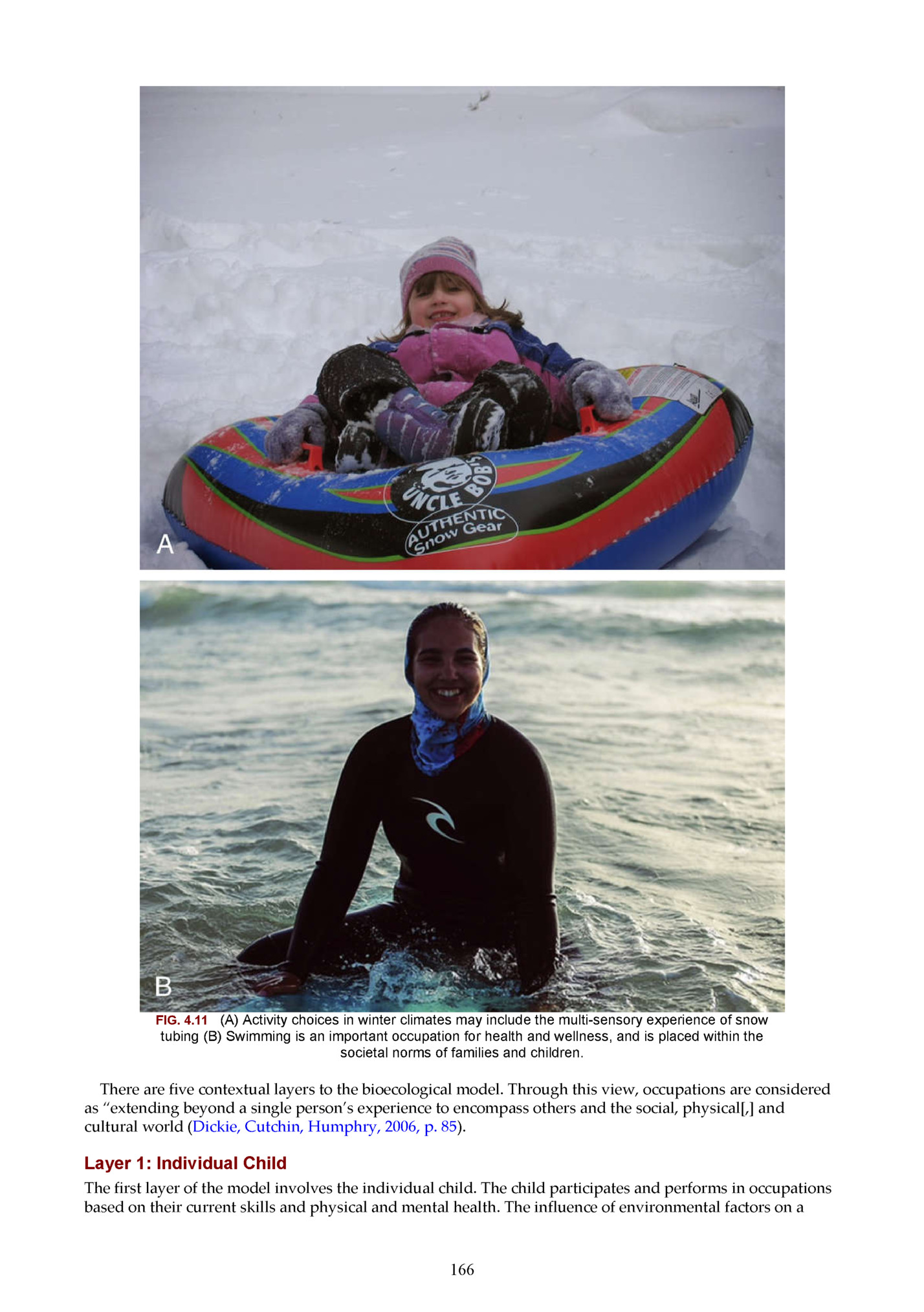
proposed that individuals must satisfy their most basic needs of food, water, rest, air, and warmth as well as a need for love and belonging before they are motivated by or interested in other life goals. Foundational biologic and egocentric needs must be satisfied before an individual has social interests and can fully participate in social relationships. With important social relationships established, an individual becomes interested in the broader community and has a broader sense of commitment and responsibility to others within the community. Children grow and develop into competent occupational beings and full participants in the community through an interaction between the child’s biologic and emotional being and his or her cultural, social, physical, virtual, and temporal contexts. Variables internal to the child can overcome negative contextual affordances, such as homelessness. Although children with strong resilience may overcome a high-risk environment (e.g., abusive situations, poverty), both internal (e.g., child’s intelligence, positive affect, emotional regulation) and contextual (e.g., supportive family relationships) protective factors are needed for positive outcomes (e.g., school success, positive relationships). FIG. 4.12 Transactional Relationships and Context Affecting Child Development [adapted from Brofenbrenner’s Socio-Ecological Model (1979, 1998)]. A child’s overall participation and performance in daily occupations is often judged based on the ability to be socially involved and interactive with others. A achment to a primary caregiver influences social relationships and intimacy throughout life. A achment to caregivers provides the child with an understanding of emotions and social relationships. Successful accomplishment of a achment in infancy results in a sense of security, and separation from the a achment figure leads to infant distress (Bowlby, 1982). Five pa erns of a achment have been identified in infants: 1. a secure pa ern that results from interactions with a caregiver who is sensitively responsive to the infant’s signals, reading them accurately and responding appropriately; 2. an anxious pa ern characterized by clinginess or need for constant reassurance, related to a parent who is excessively protective; 3. an insecure-avoidance pa ern of minimal emotional expression related to a less responsive, slightly rejecting caregiver; 4. an insecure-ambivalent pa ern related to a caregiver who appears to be overinvolved, inconsistent, or neglectful in his or her responses to the child; and 5. a disorganized pa ern that results from parents who are intrusive, withdrawn, negative, or abusive (Bowlby, 1982). Emotional regulation 167
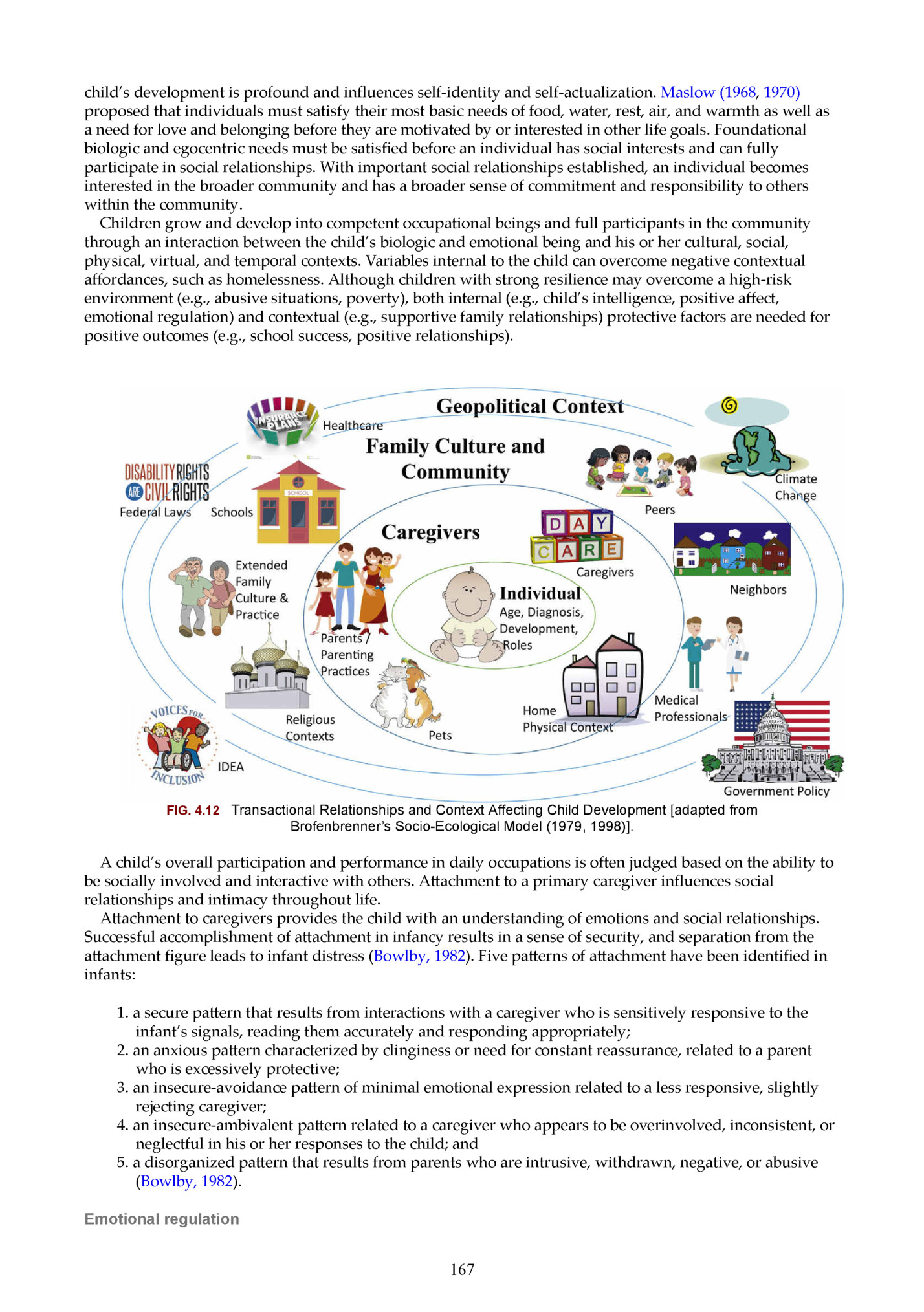
for more intervention suggestions. Emotional regulation refers to the modulation of emotional reactions, including its inhibition, activation, and grading (Bhavnagri, 1997). Child and youth temperament reflect relatively stable traits that influence the child’s style of social interaction and occupational participation. Nine areas of temperament have been identified: (1) activity level; (2) approach or withdrawal; (3) distractibility; (4) intensity of response; (5) a ention span and persistence; (6) quality of mood; (7) rhythmicity; (8) threshold of response; and (9) adaptability. Each of these areas contributes uniquely to the child’s preferences, interests, and style in forming social relationships and responding to the social environment (Bornstein, 2012). Emotional regulation includes the child’s ability to control his or her emotions and use adaptive behaviors when frustrated or experiencing negative emotions. Emotional regulation increases with age and shifts from external sources of control to internal child factors. See Appendix 4.3A for an overall description of the development of emotional regulation and Appendix 4.3B for more detailed description of emotional regulation behaviors. A child’s self-regulation of emotion emerges from socialization with primary caregivers and others and is linked to language and cognitive development. In early emotion regulation, physiologic and sensory modulation determines behavior; however, as toddlers learn self-control, between 2 and 3 years of age, the child’s behaviors become more influenced by relationships with caregivers, activity participation, and social demands (Gialamas et al., 2014). The self-control learned in the second and third years becomes more flexible and adaptable as rules are learned and remembered (Kopp, 2009). In middle childhood, well-developed problem solving and communication skills are important to a child’s ability to deal with stress. Resilient children tend to be reflective rather than impulsive, demonstrate an internal locus of control, and use flexible coping strategies in overcoming adversity (Werner & Smith, 1992). Children who achieve self-regulation of emotions can use multiple strategies flexibly to cope with stressful events. For example, a child can shift a ention away from a distressing event to decrease arousal or can focus a ention on positive aspects of an event. A child’s positive affect appears to increase emotional regulation, and children who have frequent positive experiences are be er able to cope with negative experiences or stressful events within the school and community (US Department of Education, 2007). Adults can foster selfregulation in children. This approach, called coregulation, occurs by providing children with warm, responsive adult relationships, structuring the environment for emotional safety to explore and learn at their own pace, and teaching and modeling self-regulation skills with opportunities for practice and feedback (Rosanbalm & Murray, 2017). Self Determination and Self-Identity Intrinsic and extrinsic factors influence a child’s development of self-identity, personal well-being, and selfdetermination. Bandura (1999) explained that children are inherently self-organizing and goal-directed; they typically have interest in new events and activities, initiate new tasks, and persevere in those tasks they find enjoyable. When they succeed, positive self-efficacy is reinforced, and they a empt other challenges. Selfefficacy is highly linked to learning and occupational development because it influences levels of motivation, initiative, and perseverance (Bandura, 1999; Kielhofner, 1985; Taylor, 2017). Feelings of accomplishment promote self-efficacy as shown in Fig. 4.13. Ryan and Deci (2000) further developed the theory of self-efficacy by explaining that the key elements of self-determination are competence, autonomy, and relatedness. When children feel competent, they believe that if they persist in an activity, they will succeed. A child who succeeds in performing is more likely to persist. Occupational therapists use the social, physical, and cultural environments to promote a “just-right challenge” to ensure success for all children. Children who perceive themselves to be autonomous are intrinsically motivated to explore, learn, perform well, persist, show interest, and act energetically. Children with high autonomy and intrinsic motivation are likely to be self-directed and to have high self-esteem and general well-being. Parents and occupational therapists who promote a child’s autonomy and competence are likely to instill intrinsic motivation. Competence and autonomy appear to be linked, in that feelings of competence do not enhance intrinsic motivation unless accompanied by a sense of autonomy (Santrock, 2009). Autonomous, intrinsically motivated pursuits are characterized by curiosity, meaningfulness, interest, and enjoyment. Relatedness influences the development of intrinsic motivation. When children are asked to perform a task or learn a new behavior, they become more competent and successful in the presence of a caring adult or interested caregiver. Children learn to be active participants in their daily occupational routines with supportive adults. Participation in cooccupations (engagement that has distinct or overlapping meaning or purpose for two people) forms a foundation for emotional growth, increased autonomy, and intrinsic motivation leading to increased participation (Edsaile & Olson, 2004). Fig. 4.14 shows an adult-child relationship. 168
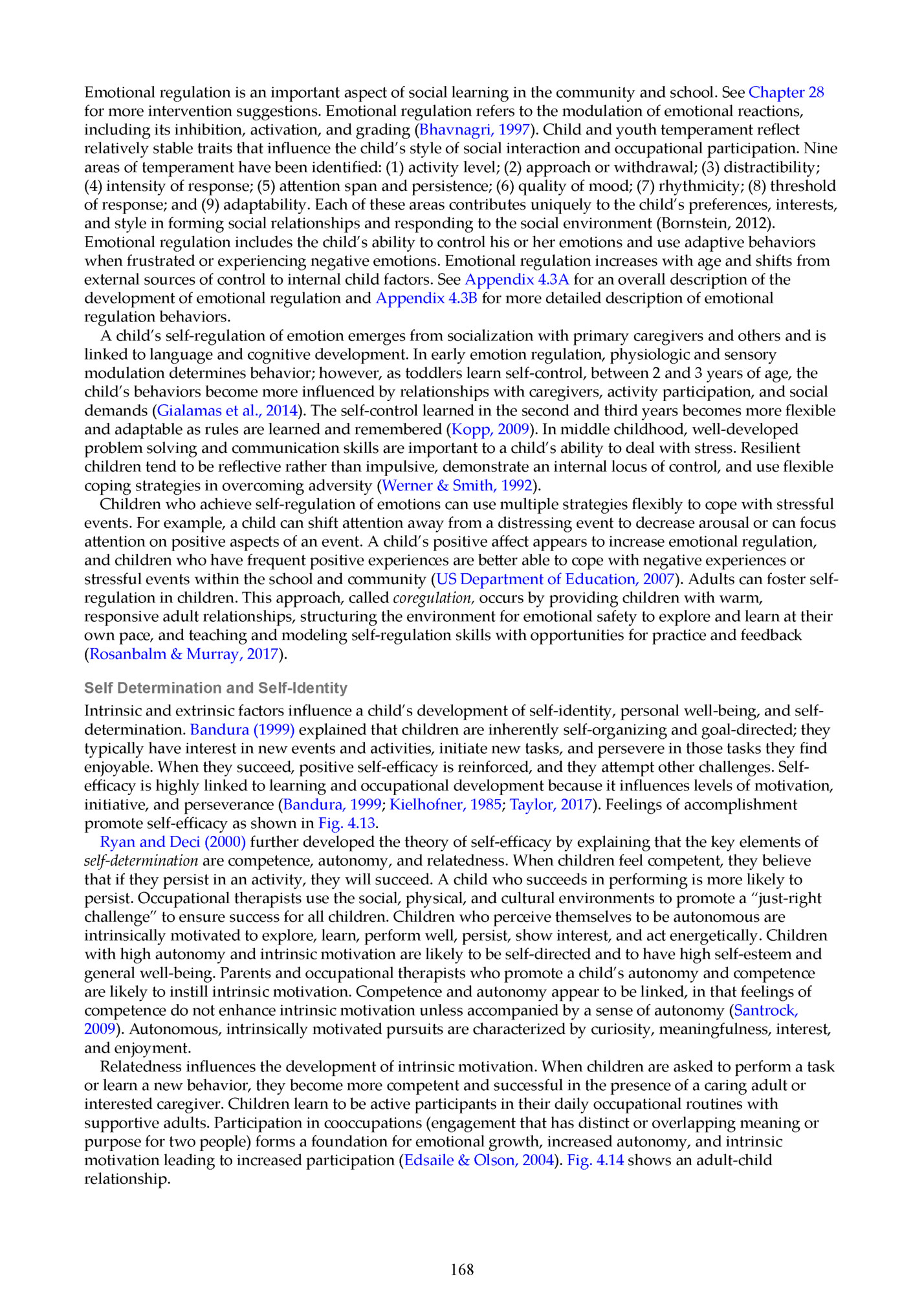
Adverse Childhood Experiences Children can be affected by adverse childhood experiences (ACES) that may affect occupational performance. Adverse childhood experiences (ACEs) are traumatic events experienced by a child before the age of eighteen. These traumatic events include emotional, physical, or sexual abuse; emotional or physical neglect; parental mental illness in the household; parental separation or divorce; mother treated violently; household substance abuse; and household criminal activity. A study surveying over 17,500 participants regarding a history of exposure to childhood abuse, neglect, and later life health and well-being found that 67% of the population experienced at least one adverse childhood experience and one in eight of the participants experienced four or more (Feli i et al., 1998). The higher the ACE score, the worse the long-term health outcomes. These results reveal that exposure to environmental threats has long-term consequences on the neurophysiological and psychological systems of the individual. (Research Note 4.1). Occupational therapists observe and assess children and families and play a role in identifying trauma that may influence a child’s occupational performance. Trauma has a significant impact on health, wellness, and the ability to safely and functionally engage in everyday roles, routines, and occupations (AOTA, 2018). See Fig. 4.15 outlining the ACE pyramid. See Chapter 28 for more on adverse childhood experiences. Case Example 4.2 provides an example showing how adverse experiences affect children and how occupational therapists may intervene. Resiliency A resilient child has internal characteristics that enable him or her to thrive and develop despite high-risk factors (such as child abuse, parental mental illness or substance abuse, or socioeconomic hardship). Children who are resilient develop positive interpersonal skills and competence despite stressful or traumatic experiences known to limit developmental potential (e.g., foster care or traumatic brain injury). Both child protective factors (e.g., intelligence, prosocial behavior, and social competence) and family protective factors (e.g., material resources; love, nurturance, and sense of safety and security; quality of parent–child relationship) are important to positive child outcomes. A high-quality relationship with at least one parent, characterized by high levels of warmth and openness and low levels of conflict, is associated with positive outcomes across levels of risk and stages of development (National Research Council, 2008). In addition, relationships with caring, mentoring adults has positive effects on the occupational development of all children, but especially homeless adolescents or adolescents in foster care (National Research Council, 2008). 169
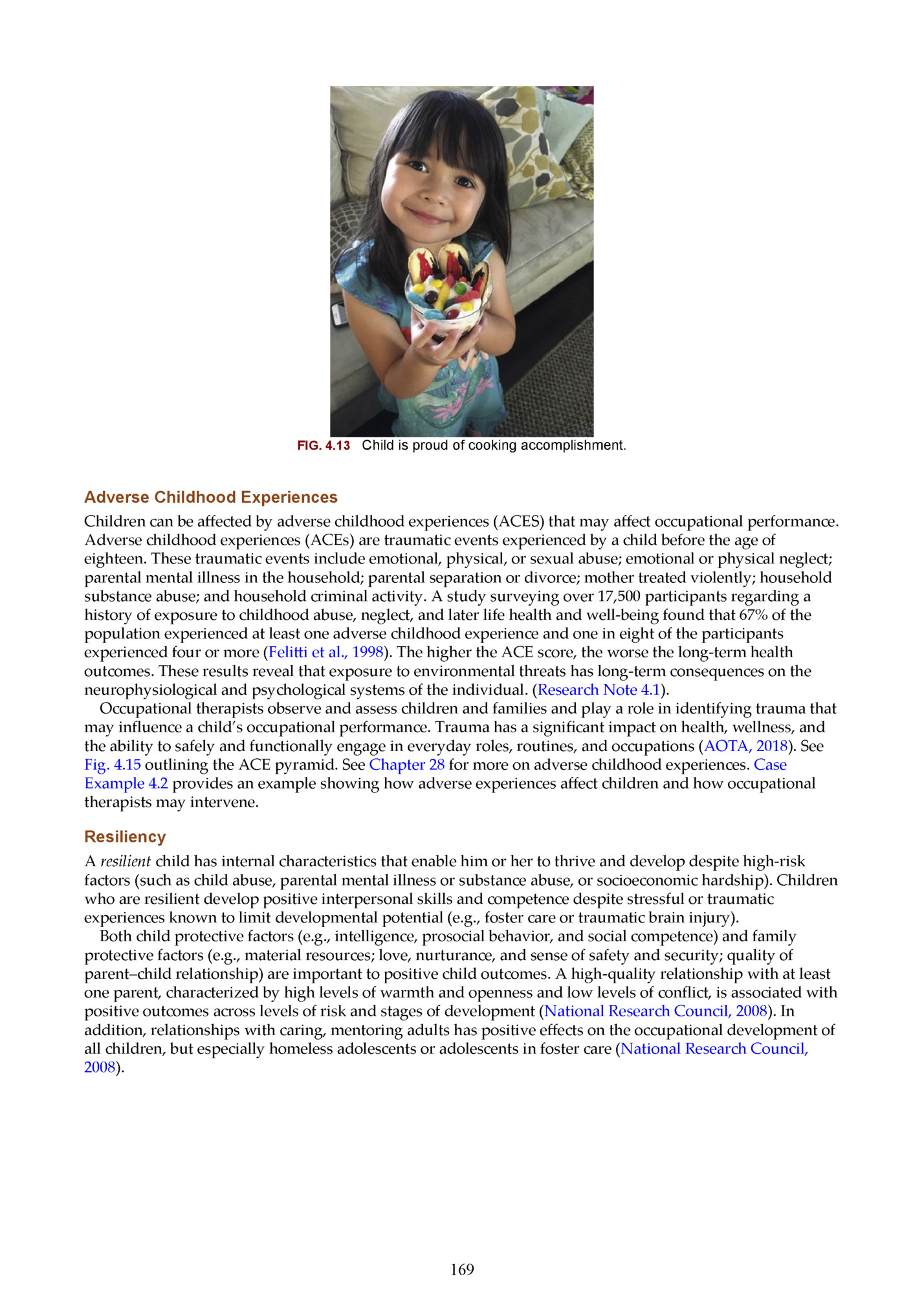
school, and community occupations. Research Note 4.1 Oh, D. L. et al. (2018). Systematic review of pediatric health outcomes associated with childhood adversity. BMC Pediatrics, 18(1), 1–19. h ps://doi.org/10.1186/s12887-018-1037-7 Overview: A systematic review was conducted to be er understand the pediatric health outcomes associated with childhood adversity. PubMed, PsycARTICLES, and CINAHL were searched for relevant articles. Longitudinal studies examining various adverse childhood experiences and biological health outcomes occurring prior to age 20 were selected. Mental and behavioral health outcomes were excluded, as were physical health outcomes that were a direct result of adversity (i.e., abusive head trauma). Data were extracted and assessed by two independent reviewers. Findings: Thirty-five (35) studies were included in the final review. The studies found that childhood adversity was associated with delays in cognitive development, asthma, infection, somatic complaints, and sleep disruption. Studies on household dysfunction reported an effect on weight during early childhood, and studies on maltreatment reported an effect on weight during adolescence. Maternal mental health issues were associated with elevated cortisol levels, whereas maltreatment was associated with blunted cortisol levels in childhood. Exposure to childhood adversity was associated with alterations of immune and inflammatory response and stress-related accelerated telomere erosion. Implications for occupational therapy practice: Early detection of and intervention in childhood adversity has the potential to improve the health and wellbeing of children. Creating a safe and trusting environment for occupational therapy intervention includes understanding the stresses of which the child experiences. Addressing the child’s psychosocial issues and need for support and resources may change the child’s narrative and quality of life. Occupational therapists may work collaboratively with other members of the team (e.g., social workers, psychologists, teachers) to address children’s needs. Occupational therapists are uniquely positioned to work with children and families who experience trauma and pos raumatic stress disorder. Occupational therapists may gain information on aversive childhood experiences through an occupational profile, informal conversation, or by using a questionnaire. (Copies of the ACEs questionnaire are free to the public on the CDC website: h ps://www.ncjfcj.org/sites/default/files/Finding%20Your%20ACE%20Score.pdf). Layer 2: Caregivers Caregivers generally refer to parents, but may include grandparents, daycare providers, and foster parents who provide physical and emotional care of a child. Parents’ educational level, work, socioeconomic status, gender, ethnicity, cultural beliefs, and their own physical and mental health influence the child’s occupations. When caregivers are sensitive and responsive to the infant, healthy social-emotional development results (Dunst 2001; Luthar & Latendresse, 2005). For example, mothers who modulate their behaviors to match their infants’ needs for stimulation and comfort also promote the infants’ abilities to self-regulate. A child’s interaction with a caregiver provides information about relationships which informs future socialization. 170
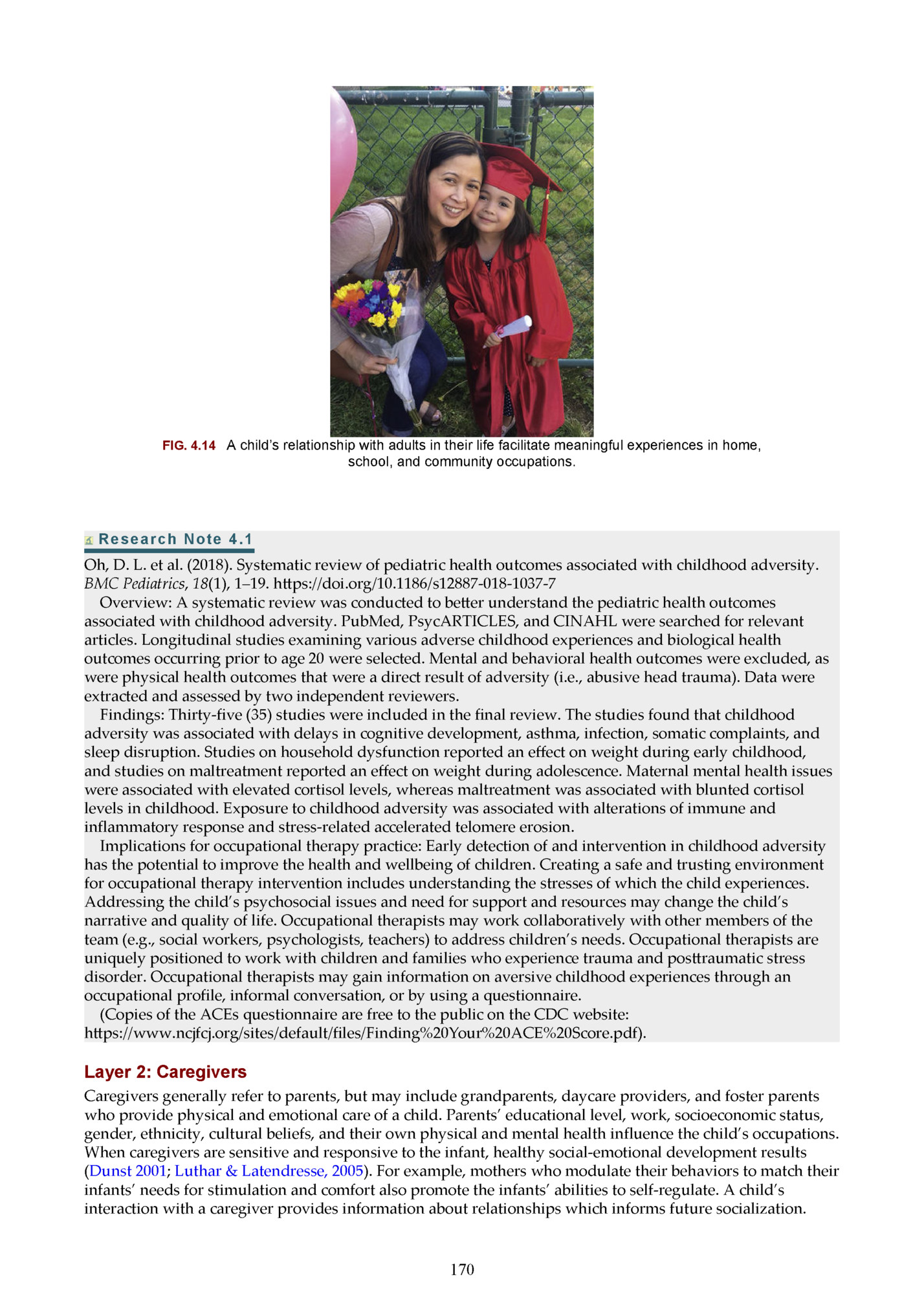
Munier, Meyers, & Pierce, 2008). Parenting may be described as a dance between supporting and challenging the child (Csikszentmihalyi & Rathunde, 1998). All parents use some measure of support to bolster children’s a empts to master skills and some degree of challenge to move children toward higher levels of mastery (Munier, Meyers, & Pierce, 2008; Rogoff et al., 1993). These elements are subtly provided by parents in the ways they present tasks and select when and how to instruct or intervene. Effective guidance relies on careful observation of the child’s cues. Sensitivity and responsivity to the child’s needs are important in promoting child development (Lerner et al., 2003). Infants receive care from childcare providers, grandparents, adult relatives, siblings, and friends. Occupational therapists may role model how to respond to children’s cues to help primary caregivers be er understand their children and promote development. See Fig. 4.16A and B showing parent-child relationships. FIG. 4.15 The Adverse Childhood Experiences (ACE) Pyramid. Retrieved from: https://www.cdc.gov/violenceprevention/acestudy/ACE_graphics.html Case Example 4.2 Critical Reflection on Adverse Childhood Experiences and Trauma James is a 13-year-old boy in the 8th grade referred for a school assessment to determine the appropriate placement and supports as he begins the transition process required by the Individuals with Disabilities Education Act (IDEA). James is diagnosed with an emotional disturbance and a ention deficit hyperactivity disorder (ADHD). He has difficulty focusing on topics for more than 5 to10 minutes and he is worried about high school next year. He can be social but is sometimes awkward socially and he admits that he is nervous around the other children. In class, James shouts out randomly, asks questions that are off topic, and interrupts his peers and teacher. His thoughts usually are related to something with the military. These behaviors distract from the class. For example, in history class, James talks about the military when a war or ba le is brought up. Often his stories are embellished to impress his peers and fit in, but they have the opposite effect. Students get annoyed with the interruption and exaggerations, and as a result he is sometimes the target of bullying. During these verbal interruptions, James often moves about his desk. Unfortunately, some staff in the building who do not understand his behaviors and find him annoying are often very short with him. James has lived with his maternal grandparents since he was 2.5 years of age when he was removed from his home for neglect. His parents were drug users and frequently left him alone. They also injected him with dissolved sleeping pills to keep him quiet. James still has scars on his arms from the injections. When he first came to live with his grandparents, he moped around and would hold out his arms at bedtime as if he 171
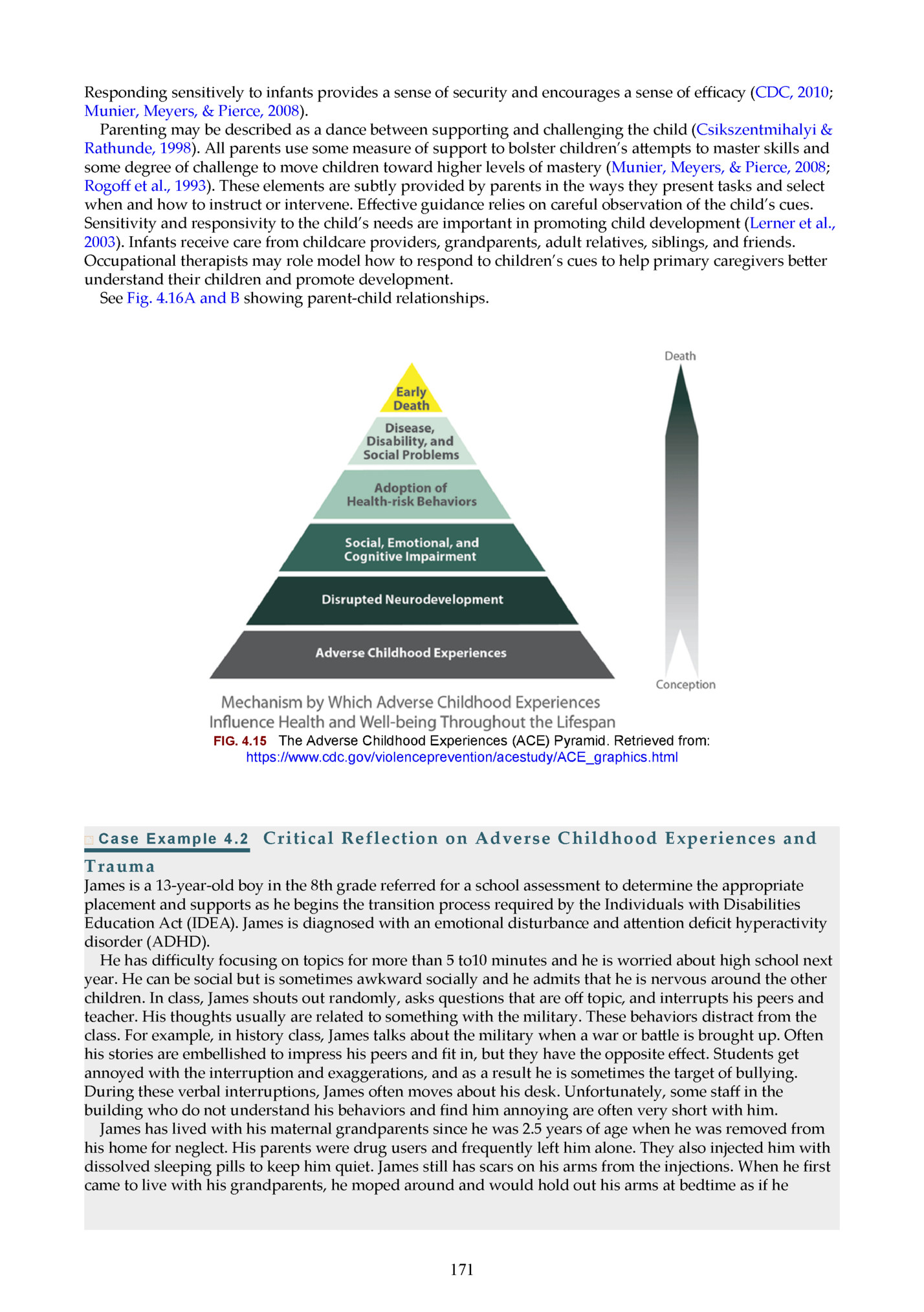
activities (fishing, baseball) with his grandparents. His grandfather passed away suddenly over 1 month ago. James usually has good a endance, but he has missed five days of school this past month (usually Mondays) because of a headache and stomachache. His grandmother reports James has more physical complaints since his grandfather’s death. To honor his grandfather who was a veteran, James is planning on joining junior ROTC when he goes to high school next year. Summary: James experienced childhood trauma but established close relationships with his grandparents. Since his grandfather died, he has difficulty in school and will benefit from supports and accommodations to allow him to feel successful in school and belong. Establishing a plan where James receives continued support and encouragement to continue in school and create future goals may include job shadowing, engaging in JROTC activities, and seeking out volunteer opportunities where he can give back to the community. James may benefit from additional help with homework at school. He will benefit from structure and support. Since he is having some difficulty in social se ings, the occupational therapist may use some social skills training to enhance James’ abilities. Furthermore, he may benefit from strategies to hold his thoughts in and ask questions later. Working with James to establish guidelines and support his progress will benefit him during high school and allow him to create lifelong strategies for tackling problems. James shows some signs of resiliency despite his aversive childhood experiences. A caring, mentoring adult may provide support so he is successful. The Individualized Education Program (IEP) team, consisting of a variety of teachers, may empower James to succeed. FIG. 4.16 (A) Social emotional development affects participation in all occupations. A child’s ability to connect and communicate with others is necessary for health and well-being and begins with attachment to primary caregivers. (B) A father and child engage in social play. Layer 3: Family Context The third layer involves the family structure and the physical environment of the family home. This includes siblings and extended family as a means of support or disruption for the parents and child. Family factors include a entiveness to a child’s needs, positive regard, and engagement in family routines. The family environment has a significantly greater effect on a child’s development than the childcare environment (Fi gerald et al., 2003). Cultural traditions and philosophies of childrearing, including acceptance of disability, are also examined in this layer. Cultural practices include the routine activities common to a people of a culture and may reflect religion, traditions, economic survival, community organization, and regional ideology. A child’s learning is highly influenced by participation in these cultural practices. Reciprocally, the child’s participation in the occupations and cultural practices of his or her family and community contribute to that community. Cultures vary in many aspects, such as the roles of women and children, values and beliefs about family and religion, family traditions, importance of healthcare and education, and the view of interdependence versus autonomy. 172

Most middle-class European Americans value independence as a primary goal for their children. Parents in the United States encourage individuality, self-expression, and independence in their children’s actions and thoughts. Families from Asian and Hispanic backgrounds often value interdependence and reliance on family members throughout the lifespan. Cultures that value interdependence over independence also value cooperation over competition. For example, children of Asian and Hispanic backgrounds are more cooperative in play than children from European American backgrounds (Rogoff et al., 1993). The social roles of young children are influenced by cultures, ethnicity, and community. In the United States, the importance of interaction with peers is stressed at young ages. Same-age peers become increasingly important through elementary school and dominate the social life of a teenager. In the United States and much of the world, children are grouped exclusively by age. These age groupings provide more opportunities for play, but they also diminish opportunities for older children to teach and nurture younger children. Younger children have fewer opportunities to imitate older children. Cultural influences on social play behaviors include time and space to play, access to objects and materials, adult behavior and a itudes, and the availability of play partners (Farver, Kim, & Lee, 1995). For example, in Hispanic communities, children spend almost all their time with siblings and other young relatives of a wide range of ages and primarily play with family members, including extended family. They socially participate in mixed-age groups, playing “on the edge” and watching intently until they can join in the play. Toddlers play with children of various ages, and they often play with older siblings. This enduring social network remains in place over time to care for, teach, and navigate children to adulthood (Rogoff et al., 1993). Interaction with children of varying ages provides older children the opportunity to practice teaching and nurturance with young children and provides young children the opportunity to imitate older children (Willinger et al., 2003). See Fig. 4.17 of a teen taking care of a young child. Layer 4: Community The community consists of institutions and people outside of the family structure. This includes peers, school, neighborhoods, religious institutions, and accessible transportation. Recreation facilities such as playgrounds and pools; open nature spaces such as hiking trails, lakes, and forests; and organizations such as Boy Scouts, sports teams, and community theater provide spaces for participation in occupational interests. Characteristics of community environments can become barriers or opportunities to occupational participation. A school context that values inclusion, Universal Design for Learning, and specialized services in the classroom se ing keeps the child engaged and integrated with peers. Schools that actively engage and include parents in the education process facilitate developmentally appropriate occupations through the transaction among the school, peers, and family culture. A community’s orientation toward children determines funding for available opportunities to play organized sports, learn about art and music, play safely in neighborhoods, and develop friendships with diverse peers. Communities that value inclusion may have soccer or baseball teams, horseback riding, and swimming specifically designed for children with disabilities (e.g., Best Buddies, Special Olympics, Miracle League Baseball, therapeutic horseback riding). Fig. 4.18 illustrates children playing soccer together. 173
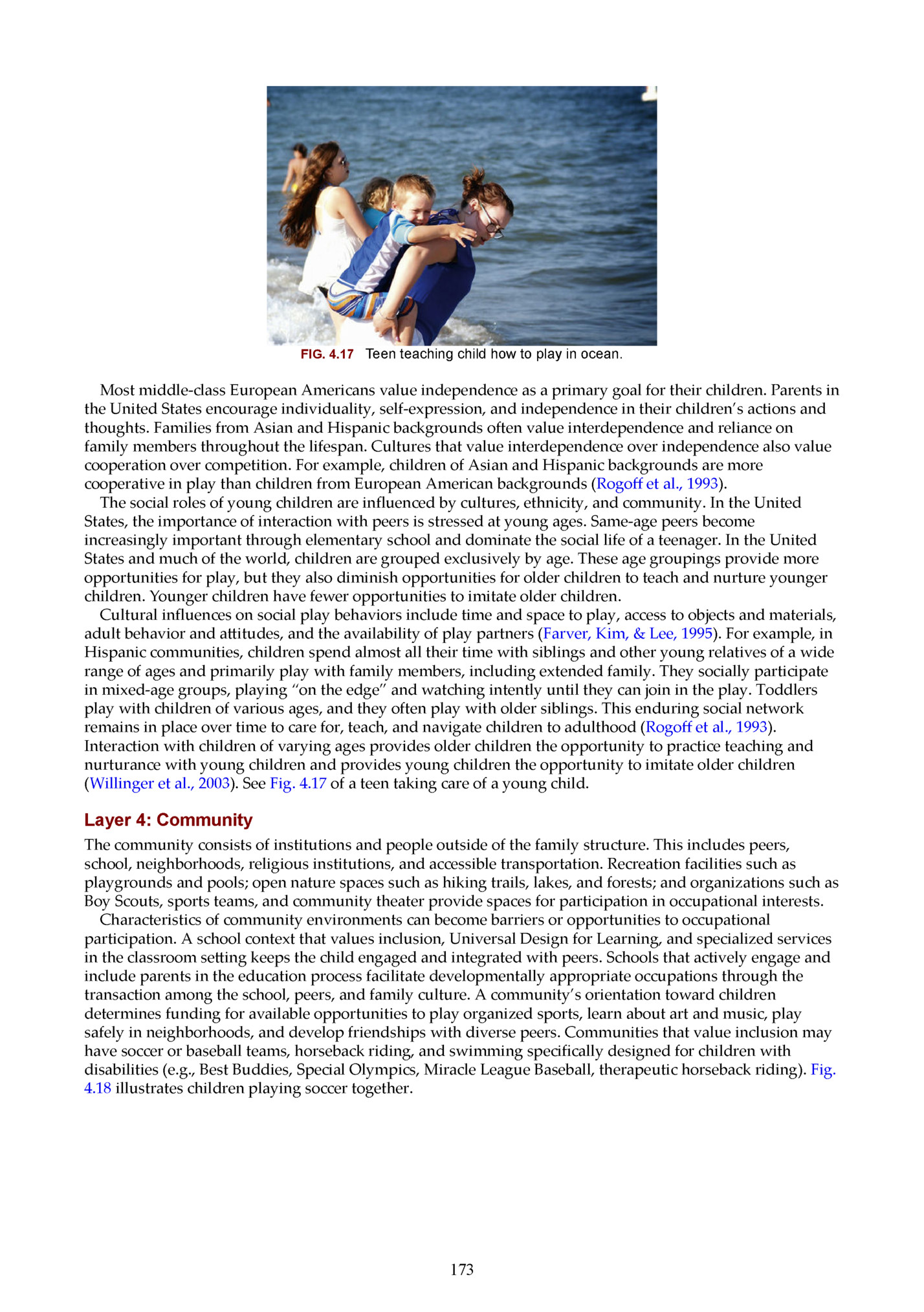
Layer 5: Geopolitical Contexts Geopolitical structures and policies affect the broader world in which children live. The geopolitical context invokes the concepts of occupational justice, occupational alienation, and deprivation, which limit an individual’s participation in living the life he or she chooses based on broader contexts out of his or her immediate control. See Box 4.2 for definitions. Historical a itudes of racism, sexism, and ableism may covertly limit occupational participation in various contexts such as home, school, and community and have a negative effect on occupational performance. This is evidenced through the statistics that fewer children of color achieve school completion, literacy, and math achievement, while more students of colors are placed in special education se ings (Children’s Defense Fund, 2017). Federal policies such as the Individual with Disabilities Education Act (IDEA, 2012) require that all students have a free and appropriate education and access to the physical and social school environment and curriculum through provision of assistive technology. The Every Student Succeeds Act (ESSA, 2017) mandates a basic level of education in the areas of literacy and math for future promotion to the workforce. Political policies regarding access to health insurance for payment of necessary services and equipment, immigration policies that separate children and families, and access to healthy foods for nutrition are examples of the broader geopolitical policies and a itudes affecting occupational development. An important aspect of the geopolitical context is the formation of a knowledge economy. The knowledge economy refers to the for-profit, information-based society. Governmental trade and policies have made technology more available and affordable and have supported the knowledge economy (Silock, Hocking, & Payne, 2014). For example, social media has changed the way the world communicates and interacts. A 2018 Pew Survey (Pew Research Center, 2018) noted that 95% of adolescents ages 13–17 owned a smartphone; 45% stated they used social media constantly; 42% of adolescents were neutral about the effect social media had on their well-being; 31% of those surveyed felt social media was generally positive, and 24% felt it was generally negative. Social media and the knowledge economy are a part of modern living and reflect a way of being that takes for granted social realities. See Box 4.3 for effects of social media on teens. Fig. 4.19 shows child using the internet. Box 4.2 Definitions of Terms Occupational justice is the right of every human being to meet basic needs and to be afforded equal opportunities to meet their human potential through engagement in diverse and meaningful occupations chosen by the individual (Townsend & Wilcock, 2004). Negative Outcomes of Occupational Injustice Occupational imbalance occurs when children are underoccupied, overoccupied or not participating at all. Examples of occupational imbalance include, boredom, too much homework, or too li le sleep. Occupational marginalization is a restriction in participation due to informal norms, habits, traditions, and expectations within a specific sociocultural infrastructure and not geopolitical laws or policy. Examples of this for children relate to deficits in inclusionary practice: restrictions of breastfeeding infants in public spaces; exclusion from recess games due to peer normed characteristics such as quality of running, or weight; pull-out special education services away from peers. Occupational deprivation is a “state of preclusion from engagement in occupations of necessity and/or meaning due to factors that stand outside the immediate control of the individuals’’ (Whiteford, 2007, p. 174
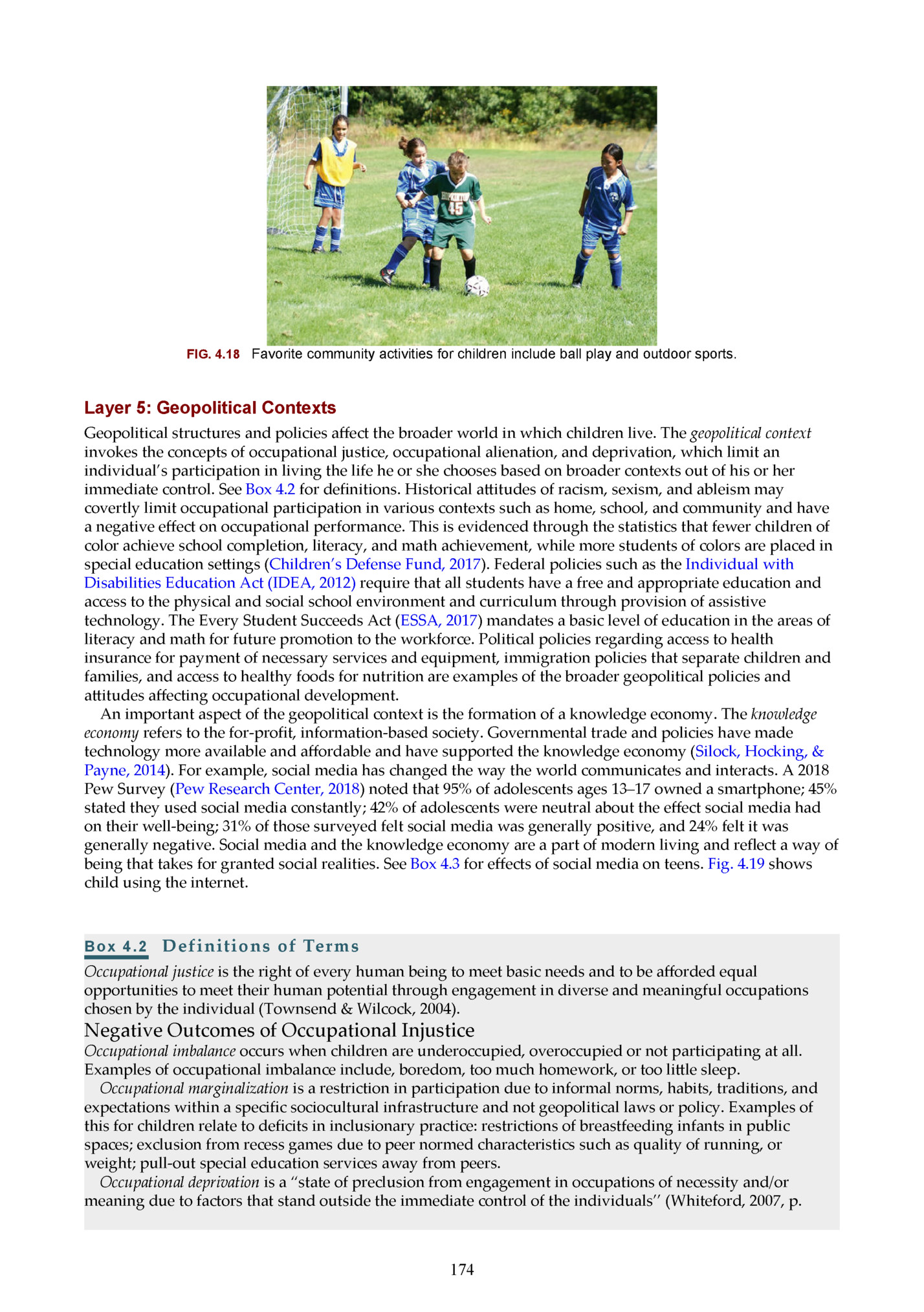
Fleepit Digital © 2021